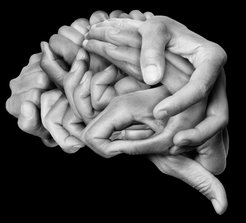Left Hand Training

In the last years, it has repeatedly been shown that the adult brain structure can undergo changes in response to changed environmental demands. It has, for example, been found that specific brain regions grow after physical exercise, intensive studying, or learning a new skill like juggling.
So far, however, relatively little is known about the temporal dynamics of these brain changes and how long they remain. In the left hand study, we aim at investigating the time frame of structural changes accompanying motor leaning. To this end, participants trained to write and draw with their non-dominant hand, over a period of 2 months. In the course of the training period, we acquired 2–3 MR scans per week, to follow the possible cascade of changes in both white and gray matter in those brain areas important for skill acquisition, within each individual.
Magnetic Resonance Imaging (MRI)

Participant working on a task to train the left hand inside the MRI.

